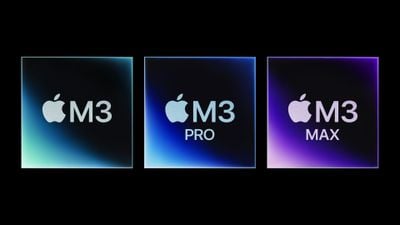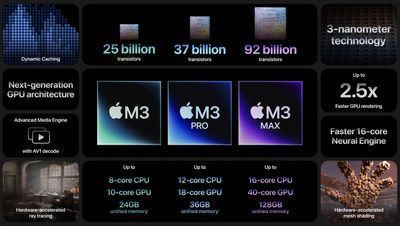Apple in October 2023 introduced its third-generation Apple silicon chips, the M3, M3 Pro, and M3 Max. The chips are Apple's first that are built on the new 3-nanometer process, an upgrade over the 5-nanometer process used for both the M1 series and M2 series chips.

This guide covers everything that we know about the M3 chips Apple has developed.
M3 Chip Explained
The M3 is Apple's latest System on a Chip (SoC) developed for use in Macs and iPads. As a "System on a Chip," the M3 integrates several different components, including the CPU, GPU, unified memory architecture (RAM), Neural Engine, Secure Enclave, SSD controller, image signal processor, encode/decode engines, Thunderbolt controller with USB 4 support, and more, all of which power the different features in the Mac.
Before Apple silicon, Macs used multiple chips for CPU, I/O, and security, but Apple's effort to integrate these chips is the reason why Apple silicon chips are much faster and more efficient than Intel chips. The unified memory architecture that Apple has included is also a major factor because all of the technologies in the M3 are able to access the same data without having to swap between multiple pools of memory.
Built into the M3 chip, the unified memory architecture means the CPU, GPU, and other processor components don't need to copy data between one another, and are able to access the same data pool. This memory architecture means that the RAM is not user upgradeable, which isn't too much of a surprise because few Macs have user-accessible RAM.
Chip Specifications
The M3 chip has an 8-core CPU and up to a 10-core GPU, while the M3 Pro has up to a 12-core CPU and up to an 18-core GPU. The M3 Max has up to a 16-core CPU and up to a 40-core GPU.

The M3 Pro and the M3 Max are also available in variants with fewer CPU and GPU cores in the 14-inch and 16-inch MacBook Pro models, while the M3 in the 24-inch iMac is available in 8-core and 10-core GPU options. There is no M3 Ultra as of yet, but when it comes out, it is likely to feature a 32-core CPU and 80-core GPU as it will be a doubled up version of the M3 Max.
Apple says that the M3 chips are able to deliver 2.5x better GPU speeds than the M1 chips while using half the power. The M3 performance cores are up to 30 percent faster than the M1 performance cores and up to 15 percent faster than the M2 performance cores. The M3 efficiency cores are up to 50 percent faster than the M1 efficiency cores, and up to 30 percent faster than the M2 efficiency cores.
Chip Comparison
| M2 | M3 | |
|---|---|---|
| Standard | 8 CPU cores (4 high-performance and 4 energy-efficient) 8 or 10 GPU cores |
8 CPU cores (4 high-performance and 4 energy-efficient) 8 or 10 GPU cores |
| Pro | 10 or 12 CPU cores (6 or 8 high-performance and 4 energy-efficient) 16 or 19 GPU cores |
11 or 12 CPU cores (5 or 6 high-performance and 6 energy-efficient) 14 or 18 GPU cores |
| Max | 12 CPU cores (8 high-performance and 4 energy-efficient) 30 or 38 core GPU cores |
14 or 16 CPU cores (10 or 12 high-performance and 4 energy-efficient) 30 or 40 GPU cores |
3-Nanometer Technology
The M1 and M2 series chips used TSMC's 5-nanometer technology, but the M3 chips are built on TSMC's newest 3-nanometer chip technology. A smaller node size equates to more transistor density, which improves both efficiency and performance. Apple's 3nm chips could offer up to 35 percent better efficiency, allowing for longer battery life for some Mac models.
Apple supplier TSMC is one of the only chip companies that is able to make 3nm chips, and rumors suggest that even TSMC's yield rates are just above 55 percent right now because the technology is so new. Apple's shift to 3nm marks the first node update since the 5nm M1 chip came out in 2020, and it will bring a bigger performance update than we saw with the M2.
GPU
Apple says that the M3 chips represent the "biggest leap forward in graphics architecture ever for Apple silicon" with faster and more efficient graphics technology. The M3 GPUs support Dynamic Caching, hardware-accelerated ray tracing, and mesh shading.
Dynamic Caching allocates the use of local memory in hardware in real time, so only the exact amount of memory needed is used for each task. It increases the average utilization of the GPU, thereby increasing performance for demanding pro apps and games.
With hardware-accelerated ray tracing, light looks more realistic as it interacts with a scene, allowing for more physically accurate images. Game developers can use the ray-tracing and mesh shading for more accurate shadows and reflections as well as more efficient geometry processing.
Battery Life
Apple silicon chips are incredibly battery efficient in addition to being faster than most Intel chips. With the M3 chip, the battery in the MacBook Pro can last for up to 22 hours.
M3 Mac Lineup
Macs That Use the M3 Chip
- 14-inch MacBook Pro
- 24-inch iMac
Macs That Use the M3 Pro Chip
- 14-inch MacBook Pro
- 16-inch MacBook Pro
Macs That Use the M3 Max Chip
- 14-inch MacBook Pro
- 16-inch MacBook Pro
Macs Expected to Use M3 Ultra Chip
Apple Silicon Mac How-Tos
Since the Apple silicon Macs are using a new type of chip designed by Apple, there are some tips and tricks for doing things like transferring files, entering recovery mode, and finding apps optimized for the new machines. We have several Apple silicon-specific how tos that are worth checking out.
- How to Use Apple Diagnostics to Test Your Mac
- How to Tell Which Apps Are Optimized for Apple Silicon Macs
- How to Transfer Files Between an Apple Silicon Mac and Another Mac
- How to Reinstall macOS on an Apple Silicon Mac
- How to Install Rosetta on Your Apple Silicon Mac
- How to Start Up in Safe Mode on an Apple Silicon Mac
- How to Install iPhone or iPad Apps on an Apple Silicon Mac
- How to Repair the Startup Disk on Apple Silicon Macs
- How to Turn Off Optimized Battery Charging in macOS
- How to Check the Battery Health of Your Apple Silicon MacBook
- How to Launch the Intel Version of a Universal Apple Silicon App
Guide Feedback
Have questions about the M3 chip or want to offer feedback on this guide? Send us an email here.




















